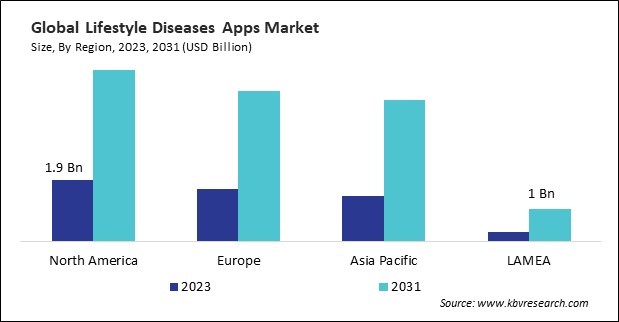Int'l : +1(646) 600-5072 | query@kbvresearch.com
Int'l : +1(646) 600-5072 | query@kbvresearch.com
Industry Insights | Market Trends | Highest number of Tables | 24/7 Analyst Support
According to a new report, published by KBV research, The Global Lifestyle Diseases Apps Market size is expected to reach $15.4 billion by 2031, rising at a market growth of 14.8% CAGR during the forecast period.
Awareness campaigns by healthcare providers and NGOs are pivotal in educating the public on lifestyle diseases and the importance of early intervention and consistent management. For example, the World Health Organization's “Beat NCDs” initiative raises global awareness about preventable lifestyle-related diseases like diabetes and hypertension while encouraging digital tools, including apps, for tracking health metrics.

The Android segment is registering a CAGR of 14.5 % during the forecast period. In the Android segment, driving factors include its widespread accessibility and affordability across developed and emerging markets, making lifestyle disease apps available to a larger demographic. Android’s extensive presence in regions with increasing lifestyle disease rates, such as parts of Asia and Africa, allows users to access health management tools for diabetes and hypertension.
The Smartphones segment led the maximum revenue in the Global Lifestyle Diseases Apps Market by Device in 2023, thereby, achieving a market value of $8.8 billion by 2031. Smartphones offer a powerful platform for lifestyle diseases apps, allowing users to track health metrics, receive reminders, and access health resources. Their affordability and ease of integration with other health-related services make them an accessible choice for users across demographics, fueling significant revenue growth in this segment.
The Obesity segment is growing at a CAGR of 13.8 % during the forecast period. In the obesity segment, the driving factors include rising global obesity rates and growing public awareness of its associated health risks, such as diabetes and cardiovascular diseases. Users increasingly turn to apps that offer tailored features like calorie counting, exercise plans, and goal tracking to support weight management.
Full Report: https://www.kbvresearch.com/lifestyle-diseases-apps-market/
The North America region dominated the Global Lifestyle Diseases Apps Market by Region in 2023, and would continue to be a dominant market till 2031; thereby, achieving a market value of $5.3 billion by 2031. The Europe region is anticipated to grow at a CAGR of 14.4% during (2024 - 2031). Additionally, The Asia Pacific region would witness a CAGR of 15.6% during (2024 - 2031).
By Platform
By Device
By Indication
By Geography
Related Reports: